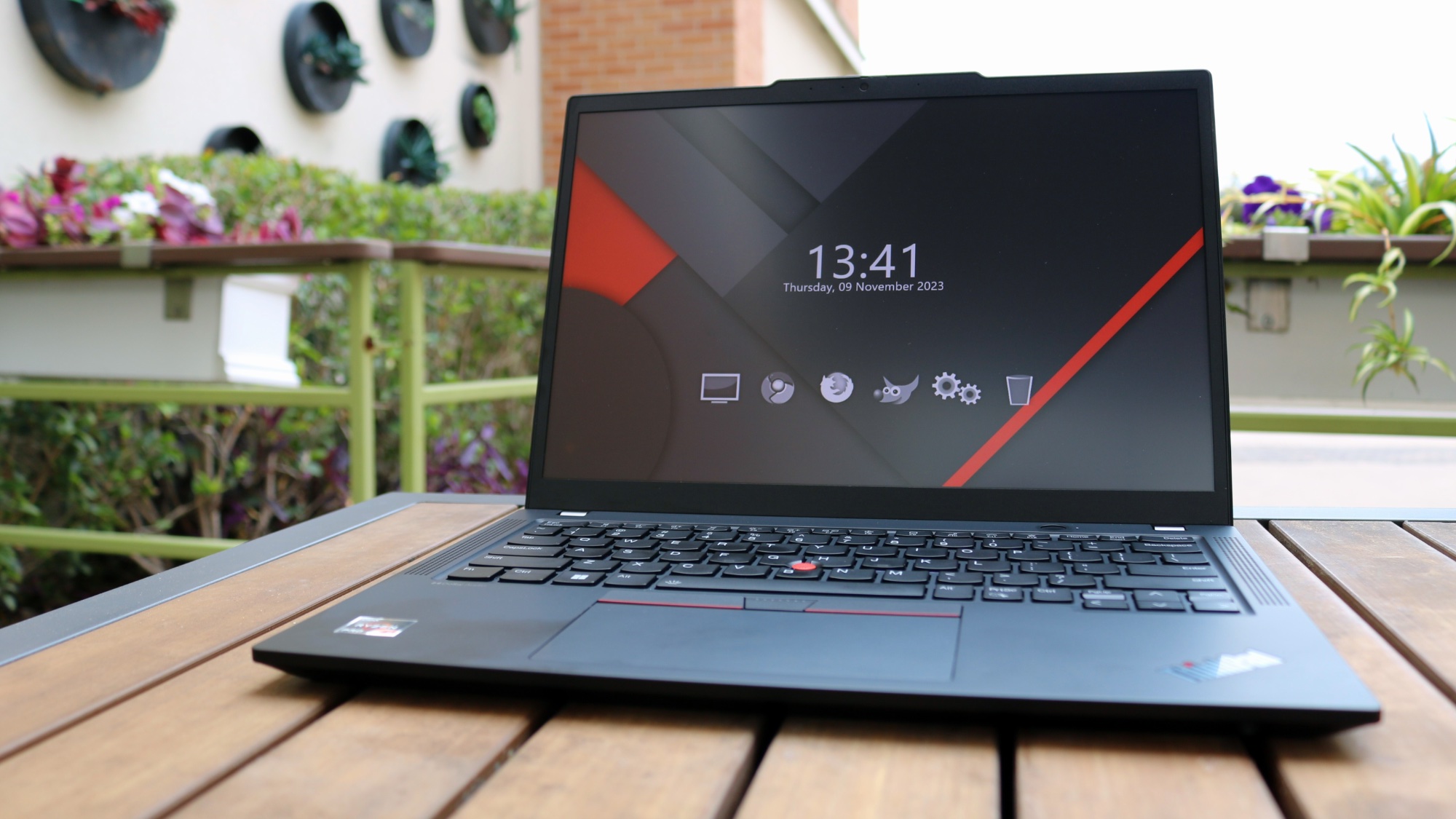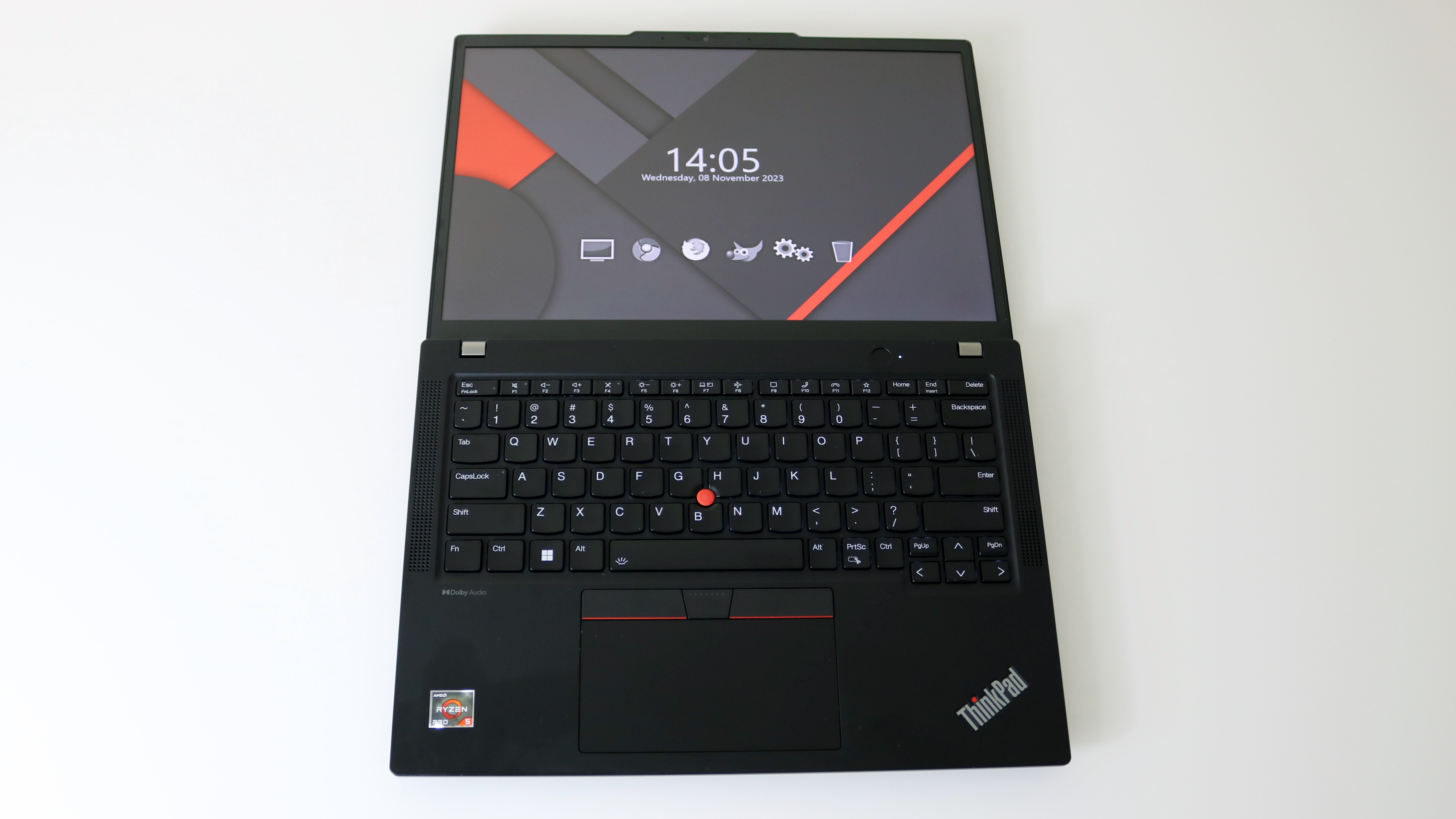I love my desktop but this ThinkPad convinced me to give laptops a second chance
Finally, a laptop that I won’t want to use with a mouse

When you think of a computer what comes to mind first? Perhaps it’s one of the best laptops like the brand new MacBook Pro M3 or the Dell XPS 13. However, as someone who grew up in the 90s back when the family computer was still a thing, I picture a desktop PC complete with a monitor, a keyboard and a mouse.
While laptops have certainly come a long way from the bulky, less powerful notebooks we had just a little more than a decade ago, I still prefer doing most of my work on a desktop. There’s plenty of reasons why, like being able to use a mechanical keyboard and a trackball mouse or the extra screen space you get with an ultrawide monitor.
Even though I use a desktop all day every day, I’m not stuck in the same location as I actually have several scattered around my house with three in my office alone. What can I say, I’m a sucker for accessories like the foot pedal I have under my desk or the mini macropad I use to control the volume on my computer. I’ve tried using a laptop as my main machine over the years but as they all ended up connected to a monitor with a keyboard and mouse plugged in, I came to the conclusion that laptops just weren’t for me.
Sure, I’ve reviewed laptops like the Microsoft Surface Laptop Go 3 and I do stay up to date on all the new designs and form factors as part of my job, but as I’ve been working from home exclusively for the past five years, it just didn’t make sense to try giving a laptop another go. That is until I started taking a closer look at Lenovo ThinkPads.
Known as some of the best business laptops you can buy, ThinkPads are built differently from the ground up. You won’t find a chiclet keyboard on a ThinkPad nor will you need to worry about easily damaging one as all of these laptops undergo rigorous military-grade testing. I’ve been using my new ThinkPad X13 Gen 4 for a week now and I’m really impressed so far. Here’s why I chose one of these iconic laptops over every other device out there as a die-hard desktop user.
Ultraportable yet with full-size ports

If you’re in the market for a new ThinkPad (or even a very capable used one) like I’ve been for the past few weeks, there are a ton of different models and configurations to choose from. I’ll spare you from going into the intricacies of the entire ThinkPad lineup but Lenovo has an excellent explainer if you want to learn more.
Although T Series laptops are considered the flagships, I’ve always been drawn to the smaller, more portable X Series devices. I had a chance to try out the first generation of the ThinkPad X1 Nano a few years ago and this experience led to me finally getting my own ThinkPad. While I considered picking up one of the larger, more expensive ThinkPad X1 Carbon laptops, in the end, I went with the ThinkPad X13 as I wanted an AMD chipset over one from Intel.
Get instant access to breaking news, the hottest reviews, great deals and helpful tips.
At 2.41 pounds with a thickness of 0.63 inches with the lid closed, my new ThinkPad X13 is extremely portable and can easily slide into a backpack. Despite this though, it doesn’t compromise when it comes to ports.
While other laptops like Apple’s MacBooks and many Windows machines eschew full-size ports for portability, my new ThinkPad doesn’t. It has two USB-C 4 ports for charging or using an external display but there are also two full-size USB A ports for flash drives, external hard drives and other accessories. It may not have as many ports as my desktop but thanks to its excellent keyboard and TrackPoint pointing stick (more on that later), I likely won’t even need them all. Still though, it’s always better to have more than less ports on any computer.
These days, I wouldn’t recommend that anyone buy a monitor without a USB-C port thanks to how they let you connect and charge your laptop at the same time. In fact, it’s one of the reasons I picked up a Samsung M7 Monitor at the beginning of the year. However, even the best TVs don’t ship with USB-C ports which is why having a full-size HDMI port on my new ThinkPad was so important to me. If this laptop is meant to serve as a stand-in for my desktop, I don’t want to be lugging around dongles or a docking station with it.
More key travel with fewer accessories

With 1.5mm of key travel, my ThinkPad X13 is a joy to type on even if it isn’t mechanical.
So what really makes ThinkPads different from other laptops? Well, for starters, their keyboards. Unlike Apple’s MacBooks, Dell’s XPS laptops or most other laptops for that matter, the keyboards on ThinkPads have a lot more key travel, which is ideal for someone like me that only uses mechanical keyboards. With 1.5mm of key travel, my ThinkPad X13 is a joy to type on even if it isn’t mechanical. It’s worth noting that older ThinkPads had even more key travel but in recent years, 1.5mm has become the standard across most of the ThinkPad lineup.
There is another thing that is a bit different than other laptop keyboards though. On the far left side of the keyboard, ThinkPads have a swapped function (FN) and control (Ctrl) key. This was part of IBM’s original ThinkPad design and it has remained a mainstay ever since with the reasoning behind it that you can always find the FN key using muscle memory. Fortunately for me though, Lenovo makes this easy to change and you can do so either in your laptop’s bios or through Lenovo Vantage which you also use for software and driver updates.
First introduced all the way back in 1992, TrackPoint is one of things that makes ThinkPads so easily recognizable. This small red dot under the G and H keys is actually a pointing stick you can use to control your ThinkPad’s mouse. There are also physical left, right and middle click buttons directly underneath the spacebar. This way, you don’t need to take your dominant hand off the keyboard to click on links, close windows, etc.
Unfortunately, if you are a fan of pointing sticks, Lenovo is really your only option these days. This is because Dell, HP, Toshiba and other laptop makers that used to offer their own TrackPoint alternatives no longer do.
What I really like about using the TrackPoint on my ThinkPad is that it allows for the same kind of precision I’m familiar with from using a trackball mouse on my desktop. It also makes scrolling through long documents or articles easier, since instead of using the page up or page down buttons, I can hold the middle click button down while scrolling with the TrackPoint.
Even if TrackPoint just isn’t for you, my ThinkPad also has an excellent (though smaller) trackpad and the configuration I chose came with a touchscreen. With three different ways to interact with what’s on the screen, it really makes me feel like a power user even if I’m using a laptop instead of a desktop with a split keyboard and trackball mouse.
No laptop will ever replace my desktop but this one comes close

I’ve been eying ThinkPads for years now and I’m glad I finally took the plunge and got one of my own. While I still plan on using a desktop as my main machine, if I want to work somewhere else around the house like at the kitchen table or on the couch, now I can. Likewise, throwing my ThinkPad into a bag and heading out to a coffee shop to do some work is another alternative and thanks to TrackPoint, I won’t need to pull out a mouse to actually get some work done.
To replace my desktop once and for all, I’d need a laptop that doesn’t exist yet. You see, my perfect laptop would have a 21:9 screen (like an ultrawide monitor) with a centered mechanical keyboard. So far, the only device that comes close to this is another laptop from Lenovo and it also happens to be a ThinkBook: the ThinkBook Plus Gen 3. However, its keyboard is positioned off to the left to make way for a 8-inch secondary screen on the right. As the ThinkBook Plus Gen 4 swapped this ultrawide screen for an E-Ink display on the back, we might not see another laptop that comes close to my dream machine anytime soon.
Still though, my new ThinkPad X13 checks almost all of the boxes for me when it comes to a laptop for work. While I love Chromebooks and the Chromebook Duet 3 has been a great device for getting some work done, without Windows I just can’t run programs like GIMP locally which are essential to my workflow.
One of the best things though is that like other ThinkPads, mine is easy to open up and poke around inside when something goes wrong or needs an upgrade. For instance, instead of having to bring it to the Apple Store or send it back to the manufacturer, I can order a new, larger battery online and swap it out myself. This will let me use my ThinkPad for years to come without having to be tethered to a power cord. Because at that point, I’d rather stick with my desktop.
More from Tom's Guide
- I went hands-on with a ThinkPad made of flaxseeds
- Black Friday gaming laptop sale — 7 deals I would snag now
- These are the best Lenovo laptops you can get right now

Anthony Spadafora is the managing editor for security and home office furniture at Tom’s Guide where he covers everything from data breaches to password managers and the best way to cover your whole home or business with Wi-Fi. He also reviews standing desks, office chairs and other home office accessories with a penchant for building desk setups. Before joining the team, Anthony wrote for ITProPortal while living in Korea and later for TechRadar Pro after moving back to the US. Based in Houston, Texas, when he’s not writing Anthony can be found tinkering with PCs and game consoles, managing cables and upgrading his smart home.
